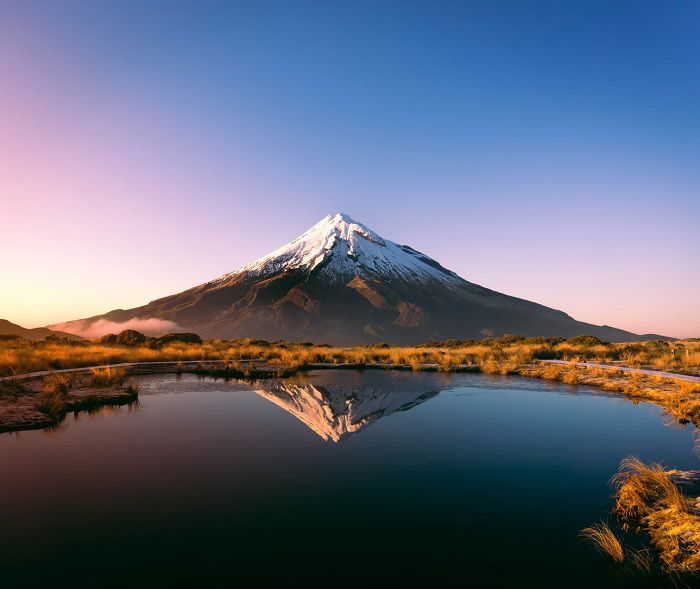Wildlife photography blends my love of nature with my love of photography. But capturing those frisky critters in an image is a challenge.
Here are 12 tips for better wildlife photography composition. I’ll talk about composition, how to prepare for a photo shoot, and what camera settings to use.
Whether you want to photograph hummingbirds or zebra, these composition and wildlife photography tips will help you make amazing wildlife photos.
The golden rule of wildlife photography is Be Ready!
That means being ready with your camera settings. There are some situations where you won’t have time to fiddle with your camera, so let me start with a basic setup.
As a wildlife photographer, I have a pre-programmed mode for wildlife photography set up on my camera. This means I can change all my settings quickly.

I shoot in Manual Mode. My default settings are f8.0, 1/1000 of a second shutter speed, and auto-ISO (with the maximum set at 5,000). From here, I can change settings depending on lighting conditions and how quickly the wildlife is moving.
For a shallower depth of field, I widen the aperture to f5.6 or f2.8. With slower moving animals, a shutter speed of 1/500 of a second might be fine, but quick birds may need a faster shutter speed (1/2000 of a second).
If my light is even, I can switch out of auto-ISO and if the conditions are dim, I can increase my maximum ISO to 8,000 or even 10,000 in a pinch.
I also shoot on silent mode (a feature available in some mirrorless cameras). I enable burst mode and continuous autofocus. I’ll talk more about these settings later in the article.
I may only get one attempt at a photograph, so I don’t turn off or let my camera go to sleep. I may have only a split second to react and my camera needs that second to start up and focus.
Let’s face it, we can’t always get close to the animals we want to photograph (and sometimes, we wouldn’t want to)!
They generally flee when they hear us coming. We sometimes catch only a fleeting glimpse or hear a rustle in the bushes. If we’re able to photograph the animal, it’s only from a distance.
The most impactful wildlife images show us wildlife close-up. It’s a view that most people don’t often experience except through photographs.
It’s ok to leave a bit of space for the animal to visually move, but if there’s too much space then the image becomes more of a landscape composition.

We connect with both people and animals through the eyes.
Making eye contact with the animal you’re photographing will draw the viewer into your image. Eye contact creates beautiful wildlife photography composition.

If possible, photograph wildlife in their natural space. This means being at their eye-level or even lower. Framing your shot from an eye-level or a lower vantage point will give the animal a sense of dramatic power.
Shooting from above will make the animal appear smaller and weaker.

Burst mode may be one of the most underutilised settings on your camera. In burst mode, my camera fires off multiple shots each time I press the shutter button.
Animals often move through my frame, changing by the second. Burst mode ensures I’ll capture every subtle motion (a slight tilt of the head, a look, a stance, a snarl).
Burst mode gives me the option of choosing the best photography composition later.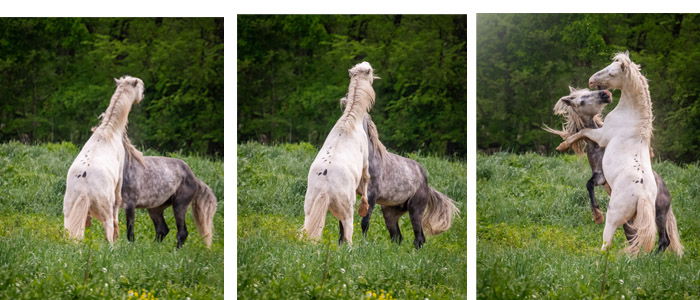
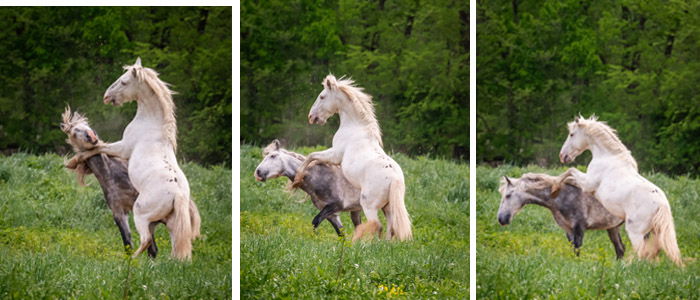
In wildlife photography composition, the first step is to capture a documentary image of an animal. This is a photograph of what the animal or bird looks like. The next step is to capture the wildlife in action. Action composition shots are more interesting.
There are some obvious action shots for instance birds in flight, animals eating. I do a bit of research to find out what sorts of action I can expect from the type of wildlife I’m photographing.
For instance, what does mating behavior look like for this animal and when is mating season?
When I photograph wild horses, their predominant activity is grazing. They seem to do this 90% of the time. I capture a lot of shots of this behavior. Then I look for more interesting action.
I wait, sometimes for quite a while, for the horses to do something else. These behaviors are less often seen so make for more interesting composition in photographs.
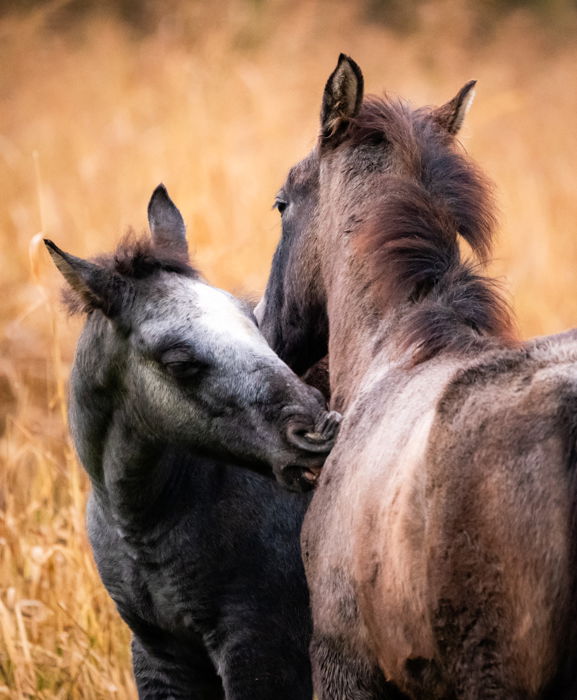
As long as the animal’s eyes are in focus, everything else is optional. It is satisfying to freeze animals in motion, but a bit of motion blur in a bird’s wings or in the running feet of a horse adds a sense of action.
To control motion blur, change your shutter speed to be a bit slower than needed to freeze the motion. If I have the opportunity, I explore different shutter speeds and then choose the photo I like best later.
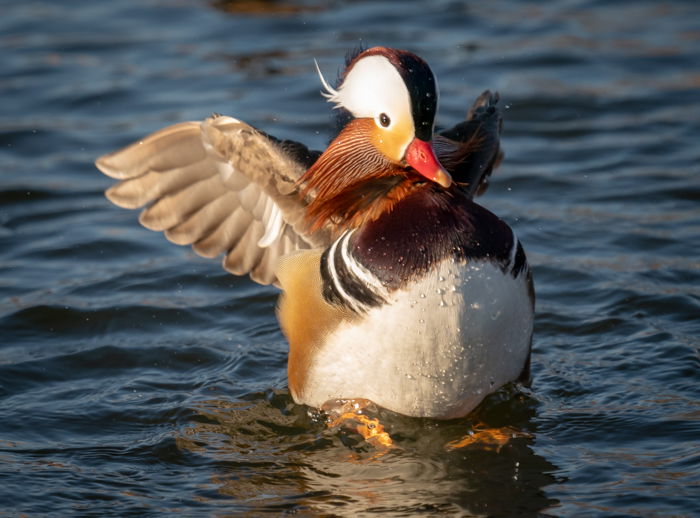
When we photograph wildlife, our attention is often completely on the animal. We might be so caught up that we miss the background.
An ideal background includes a little bit of the animal’s environment but is not distracting. It’s the background that makes the difference between a wildlife photograph and one taken at a local zoo.
Scan the background for things like sticks that might look like they are coming out of the animal’s head.
Wildlife photographers use a shallow depth of field to blur a busy background. This is much easier with a fast lens (one with a wide aperture like f2.8). It’s also easier if the animal is somewhat separated from the background.

I mentioned earlier that I often use continuous auto-focus. That is my default setting, but this setting only works well if I have a clean shot. If I’m photographing birds or monkeys in trees, my camera may not be able to figure out what I want in focus.
Sometimes the camera will guess correctly, sometimes not.
I often use autofocus to get close and then switch into manual focus to fine-tune the details. I have a hot button set up on my camera that toggles back and forth between manual and autofocus. Some lenses have this feature as well.

All photography benefits from quality light. Luckily, when the light is best in the morning and towards dusk is also when most wildlife tends to be active. The oblique light at these times of day works to make wildlife compositions more dynamic.
For wildlife, I’m often looking for soft, even light which shows details and colors. Cloudy days can be your best friend. The sky becomes a large softbox, diffusing the light evenly across the scene.
Look for light on the animals, light that highlights details and provides catchlights in the eye.

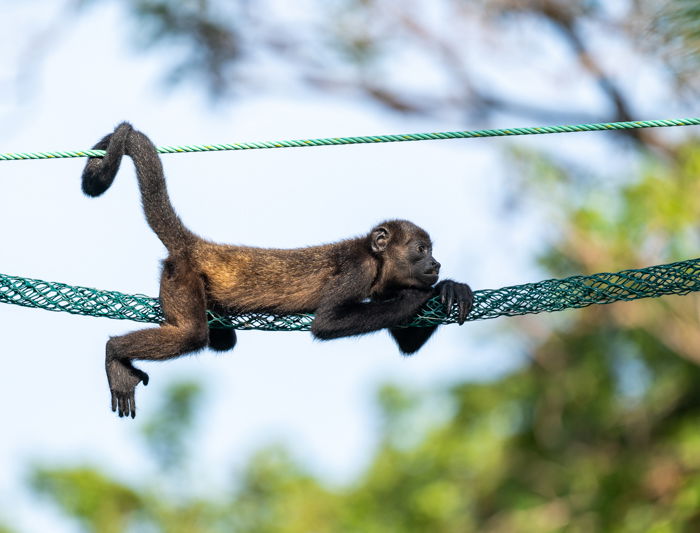
Patience is key to getting good wildlife compositions.
The best photos don’t come from chasing wildlife. Most of them can outrun you anyway! The best shots come from finding out where the wildlife will be and settling in to wait for the wildlife to come to you.
Many species repeat behavior patterns. They return to the same places again and again. Research habits and what times are the animals active. No sense in photographing when the animals are sleeping or hibernating.
Learning these patterns allows me to be at the right time and the right place for good photographs.
When wildlife shows up, I watch what they do. Sometimes I’ll pick up on individual personalities or focus on the “cute-factor”.
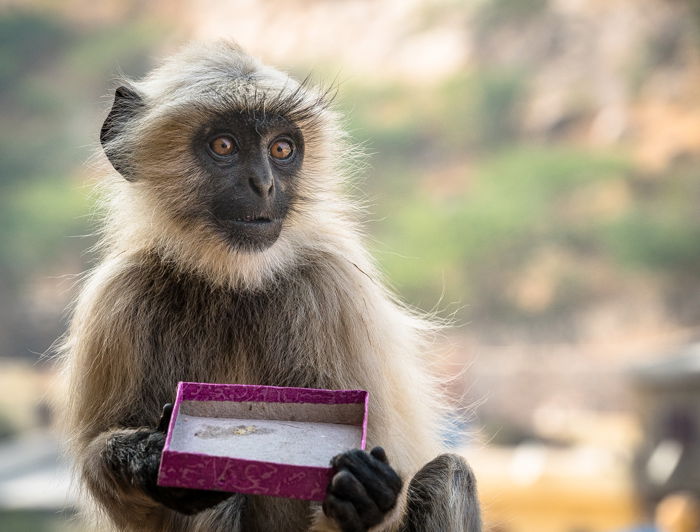
You may want to photograph bears in Alaska or toucans in Costa Rica. Before you do, practice at a local pond or park.
The squirrels and ducks may not be as exotic. But photographing the local wildlife will sharpen your tracking skills and you will have time to practice the settings on your camera.
Find out what types of wildlife is in your area and where to locate them. Research their behaviors. Find out if there are migration patterns or times of year that the wildlife may be changing colors.
Local nature societies can be a wealth of knowledge.

Capturing quality wildlife photographs with beautiful composition takes time and practice, but it is worth the effort.
Do a bit of research on the wildlife you might see in an environment. Be willing to wait for the photograph. Look for interesting light and focus on the eyes.
Finally, choose camera gear and settings that help you capture these fleeting and precious moments.
